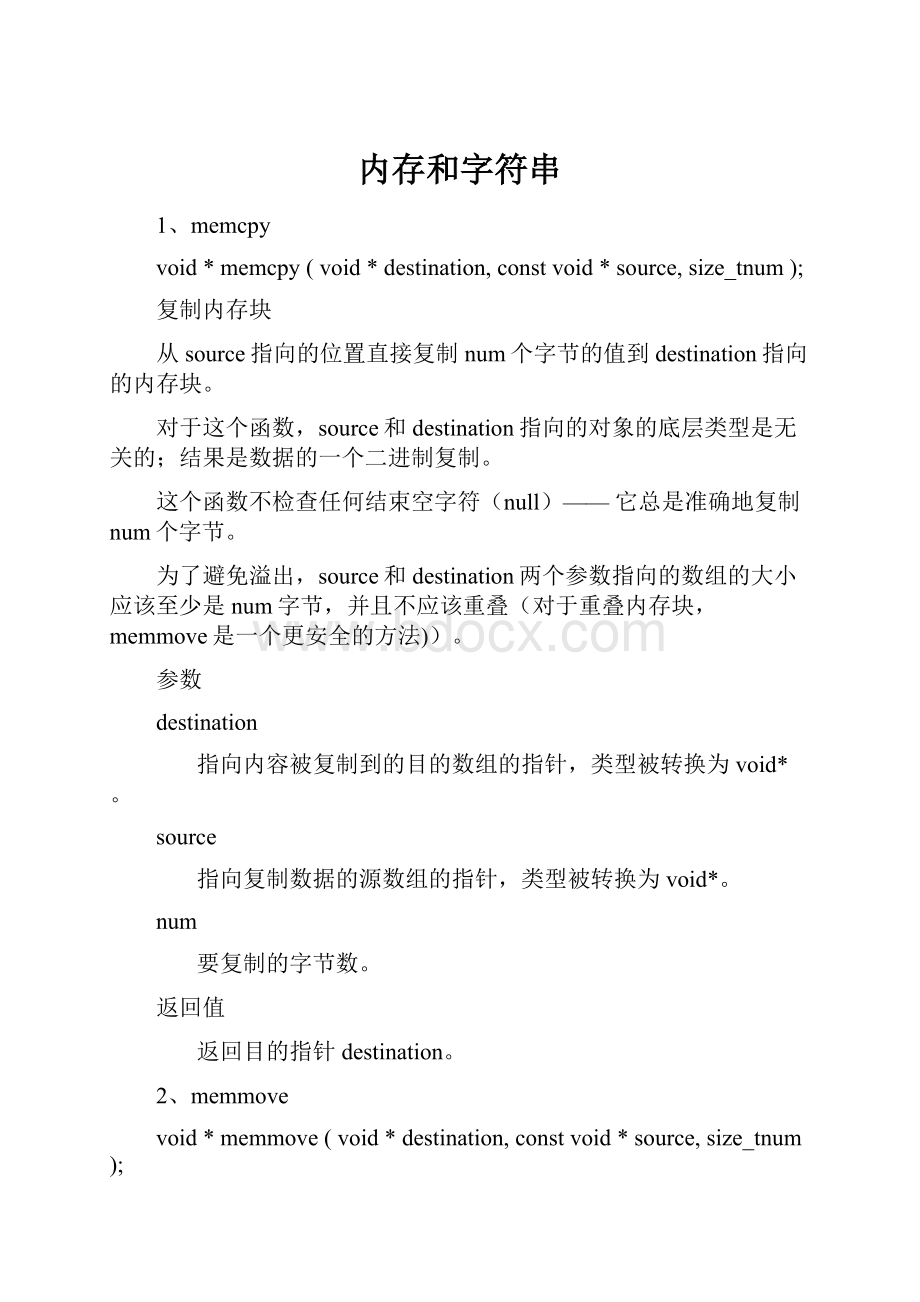内存和字符串.docx
《内存和字符串.docx》由会员分享,可在线阅读,更多相关《内存和字符串.docx(17页珍藏版)》请在冰豆网上搜索。

内存和字符串
1、memcpy
void*memcpy(void*destination,constvoid*source,size_tnum);
复制内存块
从source指向的位置直接复制num个字节的值到destination指向的内存块。
对于这个函数,source和destination指向的对象的底层类型是无关的;结果是数据的一个二进制复制。
这个函数不检查任何结束空字符(null)——它总是准确地复制num个字节。
为了避免溢出,source和destination两个参数指向的数组的大小应该至少是num字节,并且不应该重叠(对于重叠内存块,memmove是一个更安全的方法))。
参数
destination
指向内容被复制到的目的数组的指针,类型被转换为void*。
source
指向复制数据的源数组的指针,类型被转换为void*。
num
要复制的字节数。
返回值
返回目的指针destination。
2、memmove
void*memmove(void*destination,constvoid*source,size_tnum);
移动内存块
从source指向的位置复制num个字节的值到destination指向的内存块。
复制操作的发生就好像使用了中间缓存,允许destination和source重叠。
对于这个函数,source和destination指向的对象的底层类型是无关的;结果是数据的一个二进制复制。
这个函数不检查任何结束空字符(null)——它总是准确地复制num个字节。
为了避免溢出,source和destination两个参数指向的数组的大小应该至少是num字节。
参数
destination
指向内容被复制到的目的数组的指针,类型被转换为void*。
source
指向复制数据的源数组的指针,类型被转换为void*。
num
要复制的字节数。
返回值
返回目的指针destination。
3、memset
void*memset(void*ptr,intvalue,size_tnum);
填充内存块
将ptr指向的没存块的前num个字节设置为特定的值value(被解释为一个unsignedchar类型的值)。
参数
ptr
指向需要填充的内存块的指针。
value
要设置的值,这个值是作为int型传递的,但是该函数用这个值的unsignedchar类型转换值来填充内存块。
num
要是指特定值的字节数。
返回值
返回指针ptr。
4、memchr
constvoid*memchr(constvoid*ptr,intvalue,size_tnum);
void*memchr(void*ptr,intvalue,size_tnum);
在内存块中定位字符
在ptr指向的没存块的前num个字节中搜索value值得第一次出现(被解释为一个unsignedchar类型的值),并返回指向该值的指针。
参数
ptr
指向需要被执行搜索的内存块的指针。
value
需要被定位的值。
这个值是作为int型传递的,但是该函数用这个值的unsignedchar类型转换值来进行逐位的搜索。
num
要是分析的字节数。
返回值
返回指向ptr指向的内存块中value值第一次出现位置的指针。
如果没有找到value值,则该函数返回NULL。
5、memcmp
intmemcmp(constvoid*ptr1,constvoid*ptr2,size_tnum);
比较两个内存块
将ptr2指向的内存块的签num个字节与ptr2指向的内存块的前num个字节进行比较,如果它们都相符合则返回0,反之则返回一个指示其中一个较大的非零值。
参数
ptr1
指向内存块的指针。
ptr2
指向内存块的指针
num
需要比较的字节数。
返回值
返回一个指示两个内存块的内容间的关系的整型值。
0值表示两个内存块的内容是相等的。
一个大于0的值表示,两个内存块中第一个不匹配的字节是ptr1的比ptr2的大,作为unsignedchar类型比较的;小于0则表示相反。
函数名:
stpcpy
功能:
拷贝一个字符串到另一个
用法:
char*stpcpy(char*destin,char*source);
程序例:
#include
#include
intmain(void)
{
charstring[10];
char*str1="abcdefghi";
stpcpy(string,str1);
printf("%s\n",string);
return0;
}
函数名:
strcat
功能:
字符串拼接函数
用法:
char*strcat(char*destin,char*source);
程序例:
#include
#include
intmain(void)
{
chardestination[25];
char*blank="",*c="C++",*Borland="Borland";
strcpy(destination,Borland);
strcat(destination,blank);
strcat(destination,c);
printf("%s\n",destination);
return0;
}
函数名:
strchr
功能:
在一个串中查找给定字符的第一个匹配之处\
用法:
char*strchr(char*str,charc);
程序例:
#include
#include
intmain(void)
{
charstring[15];
char*ptr,c='r';
strcpy(string,"Thisisastring");
ptr=strchr(string,c);
if(ptr)
printf("Thecharacter%cisatposition:
%d\n",c,ptr-string);
else
printf("Thecharacterwasnotfound\n");
return0;
}
函数名:
strcmp
功能:
串比较
用法:
intstrcmp(char*str1,char*str2);
看Asic码,str1>str2,返回值>0;两串相等,返回0
程序例:
#include
#include
intmain(void)
{
char*buf1="aaa",*buf2="bbb",*buf3="ccc";
intptr;
ptr=strcmp(buf2,buf1);
if(ptr>0)
printf("buffer2isgreaterthanbuffer1\n");
else
printf("buffer2islessthanbuffer1\n");
ptr=strcmp(buf2,buf3);
if(ptr>0)
printf("buffer2isgreaterthanbuffer3\n");
else
printf("buffer2islessthanbuffer3\n");
return0;
}
函数名:
strncmpi
功能:
将一个串中的一部分与另一个串比较,不管大小写
用法:
intstrncmpi(char*str1,char*str2,unsignedmaxlen);
程序例:
#include
#include
intmain(void)
{
char*buf1="BBB",*buf2="bbb";
intptr;
ptr=strcmpi(buf2,buf1);
if(ptr>0)
printf("buffer2isgreaterthanbuffer1\n");
if(ptr<0)
printf("buffer2islessthanbuffer1\n");
if(ptr==0)
printf("buffer2equalsbuffer1\n");
return0;
}
函数名:
strcpy
功能:
串拷贝
用法:
char*strcpy(char*str1,char*str2);
程序例:
#include
#include
intmain(void)
{
charstring[10];
char*str1="abcdefghi";
strcpy(string,str1);
printf("%s\n",string);
return0;
}
函数名:
strcspn
功能:
在串中查找第一个给定字符集内容的段
用法:
intstrcspn(char*str1,char*str2);
程序例:
#include
#include
#include
intmain(void)
{
char*string1="1234567890";
char*string2="747DC8";
intlength;
length=strcspn(string1,string2);
printf("Characterwherestringsintersectisatposition%d\n",length);
return0;
}
函数名:
strdup
功能:
将串拷贝到新建的位置处
用法:
char*strdup(char*str);
程序例:
#include
#include
#include
intmain(void)
{
char*dup_str,*string="abcde";
dup_str=strdup(string);
printf("%s\n",dup_str);
free(dup_str);
return0;
}
函数名:
stricmp
功能:
以大小写不敏感方式比较两个串
用法:
intstricmp(char*str1,char*str2);
程序例:
#include
#include
intmain(void)
{
char*buf1="BBB",*buf2="bbb";
intptr;
ptr=stricmp(buf2,buf1);
if(ptr>0)
printf("buffer2isgreaterthanbuffer1\n");
if(ptr<0)
printf("buffer2islessthanbuffer1\n");
if(ptr==0)
printf("buffer2equalsbuffer1\n");
return0;
}
函数名:
strerror
功能:
返回指向错误信息字符串的指针
用法:
char*strerror(interrnum);
程序例:
#include
#include
intmain(void)
{
char*buffer;
buffer=strerror(errno);
printf("Error:
%s\n",buffer);
return0;
}
函数名:
strcmpi
功能:
将一个串与另一个比较,不管大小写
用法:
intstrcmpi(char*str1,char*str2);
程序例:
#include
#include
intmain(void)
{
char*buf1="BBB",*buf2="bbb";
intptr;
ptr=strcmpi(buf2,buf1);
if(ptr>0)
printf("buffer2isgreaterthanbuffer1\n");
if(ptr<0)
printf("buffer2islessthanbuffer1\n");
if(ptr==0)
printf("buffer2equalsbuffer1\n");
return0;
}
函数名:
strncmp
功能:
串比较
用法:
intstrncmp(char*str1,char*str2,intmaxlen);
程序例:
#include
#include
intmain(void)
{
char*buf1="aaabbb",*buf2="bbbccc",*buf3="ccc";
intptr;
ptr=strncmp(buf2,buf1,3);
if(ptr>0)
printf("buffer2isgreaterthanbuffer1\n");
else
printf("buffer2islessthanbuffer1\n");
ptr=strncmp(buf2,buf3,3);
if(ptr>0)
printf("buffer2isgreaterthanbuffer3\n");
else
printf("buffer2islessthanbuffer3\n");
return(0);
}
函数名:
strncmpi
功能:
把串中的一部分与另一串中的一部分比较,不管大小写
用法:
intstrncmpi(char*str1,char*str2);
程序例:
#include
#include
intmain(void)
{
char*buf1="BBBccc",*buf2="bbbccc";
intptr;
ptr=strncmpi(buf2,buf1,3);
if(ptr>0)
printf("buffer2isgreaterthanbuffer1\n");
if(ptr<0)
printf("buffer2islessthanbuffer1\n");
if(ptr==0)
printf("buffer2equalsbuffer1\n");
return0;
}
函数名:
strncpy
功能:
串拷贝
用法:
char*strncpy(char*destin,char*source,intmaxlen);
程序例:
#include
#include
intmain(void)
{
charstring[10];
char*str1="abcdefghi";
strncpy(string,str1,3);
string[3]='\0';
printf("%s\n",string);
return0;
}
函数名:
strnicmp
功能:
不注重大小写地比较两个串
用法:
intstrnicmp(char*str1,char*str2,unsignedmaxlen);
程序例:
#include
#include
intmain(void)
{
char*buf1="BBBccc",*buf2="bbbccc";
intptr;
ptr=strnicmp(buf2,buf1,3);
if(ptr>0)
printf("buffer2isgreaterthanbuffer1\n");
if(ptr<0)
printf("buffer2islessthanbuffer1\n");
if(ptr==0)
printf("buffer2equalsbuffer1\n");
return0;
}
函数名:
strnset
功能:
将一个串中的所有字符都设为指定字符
用法:
char*strnset(char*str,charch,unsignedn);
程序例:
#include
#include
intmain(void)
{
char*string="abcdefghijklmnopqrstuvwxyz";
charletter='x';
printf("stringbeforestrnset:
%s\n",string);
strnset(string,letter,13);
printf("stringafterstrnset:
%s\n",string);
return0;
}
函数名:
strpbrk
功能:
在串中查找给定字符集中的字符
用法:
char*strpbrk(char*str1,char*str2);
程序例:
#include
#include
intmain(void)
{
char*string1="abcdefghijklmnopqrstuvwxyz";
char*string2="onm";
char*ptr;
ptr=strpbrk(string1,string2);
if(ptr)
printf("strpbrkfoundfirstcharacter:
%c\n",*ptr);
else
printf("strpbrkdidn'tfindcharacterinset\n");
return0;
}
函数名:
strrchr
功能:
在串中查找指定字符的最后一个出现
用法:
char*strrchr(char*str,charc);
程序例:
#include
#include
intmain(void)
{
charstring[15];
char*ptr,c='r';
strcpy(string,"Thisisastring");
ptr=strrchr(string,c);
if(ptr)
printf("Thecharacter%cisatposition:
%d\n",c,ptr-string);
else
printf("Thecharacterwasnotfound\n");
return0;
}
函数名:
strrev
功能:
串倒转
用法:
char*strrev(char*str);
程序例:
#include
#include
intmain(void)
{
char*forward="string";
printf("Beforestrrev():
%s\n",forward);
strrev(forward);
printf("Afterstrrev():
%s\n",forward);
return0;
}
函数名:
strset
功能:
将一个串中的所有字符都设为指定字符
用法:
char*strset(char*str,charc);
程序例:
#include
#include
intmain(void)
{
charstring[10]="123456789";
charsymbol='c';
printf("Beforestrset():
%s\n",string);
strset(string,symbol);
printf("Afterstrset():
%s\n",string);
return0;
}
函数名:
strspn
功能:
在串中查找指定字符集的子集的第一次出现
用法:
intstrspn(char*str1,char*str2);
程序例:
#include
#include
#include
intmain(void)
{
char*string1="1234567890";
char*st